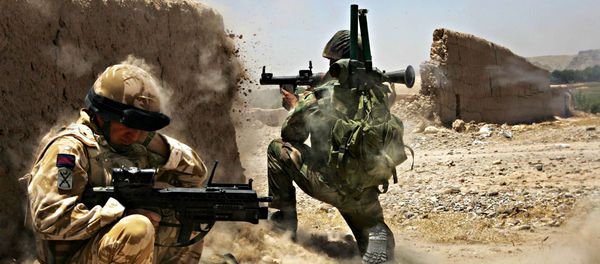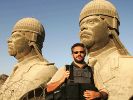Eye For Film >> Movies >> A Good Day to Die, Hoka Hey (2016) Film Review

You watch one film in a category and, like an addict, you come back for more. Which is, in the end, not unlike the addiction to war photography owned up to in the closing moments of A Good Day to Die, Hoka Hey – a documentary that explores the motivation and self-justification behind the career of self-taught war photographer Jason P Howe.
This, the official blurb claims, is a “story of survival and change” and “the story of a man's bravery to cover the world at war, and what it takes to get images published for the world to see”.

Well, up to a point. Having been remarkably impressed by Only The Dead – a film which also deals with some of the big questions around war reporting and the effect it has on those who do it - I sat down to A Good Day to Die with similar morbid curiosity: perhaps, ironically, my own anticipation is but a pale shadow of the amoral voyeurism that seems to drive these individuals; just one step further removed.
Still, is this really how the film's makers view what they have delivered here? A heroic tale of bravery, topped off with (heroic) struggle against the awful powers that be who, in their narrow-minded bureaucratic way wage a very different war against photographers behind the lines? Or is that just there for public consumption? A carefully concocted spin on the tale they are telling, designed to draw in the audience and to placate the subject of their work?
For this did not feel to me anything like the sympathetic film billed. Its subject and primary focus is Howe, who earned his photographic stripes through travel journalism. He became a war photographer in 2001 with a move to Colombia to cover the long-running war there between FARC guerillas and paramilitaries.
What follows is more revealing than insightful. His first shooting of a live combat situation, his gradual infiltration into ever more dangerous situations and his affair with a local woman who, it turns out, is actually a paramilitary assassin. The most shocking aspect is the flat, detached manner in which he describes these episodes, any one of which, for some individuals, might be basis for a film in its own right: I Married A Contract Killer or How I Missed Death By Five Metres”.
This same detachment is threaded through subsequent engagements. In Iraq, a fellow journalist reveals she took him to one side to explain that his behaviour, which might have been OK in Colombia, was wholly inappropriate in Iraq. Howe himself tells of being rebuked for wandering round a scene of mass carnage with a smile on his face.
He goes to the Lebanon where – a flicker of emotion – he is not happy that the field of war photography has been invaded by too many young photographers straight out of journalist school who just don't do things right. “Paparazzi for the dead and dying”, he complains - just five years after he decided to embark on his own career in war snappery.
He flies back to Colombia, with no advance warning, to see his ex, and is surprised to discover she has in her turn been killed. A tragedy, with only, in passing a reference to the fact that he had done nothing when she asked him to help her escape her own incredibly dangerous lifestyle.
The whole is, apparently, book-ended by the story of how Howe took and then published, despite Ministry of Defence objections, a sequence that showed, in graphic detail, a young soldier injured in Afghanistan. Another interesting, mega-story, thrown into the mix – and then just left there. For this is about censorship and how the powers that be get their revenge. The soldier in question was more than happy for the pictures to be published – which demolished the MoD's principal argument for non-publication. So they fell back on the tried and trusted “because we say you shouldn't” - and when that failed, they took their revenge, later, by refusing Howe the right to return to Afghanistan with British Forces.
Yet still, the film maintains the image of a man very little interested in self-reflection, beyond accepting that his habit of escaping to Thailand to “drink everything and snort everything and fuck everything” might not have been overly healthy.
It ends with Howe retreating to his home in Andalusia where, living only with his dogs, he must lick his wounds and deal with PTSD. Is this really a story of bravery? Or is it – as Only The Dead also hints at – a focus on the strange detached amorality that you need if you want to be a successful war reporter?
Reviewed on: 22 May 2017
















